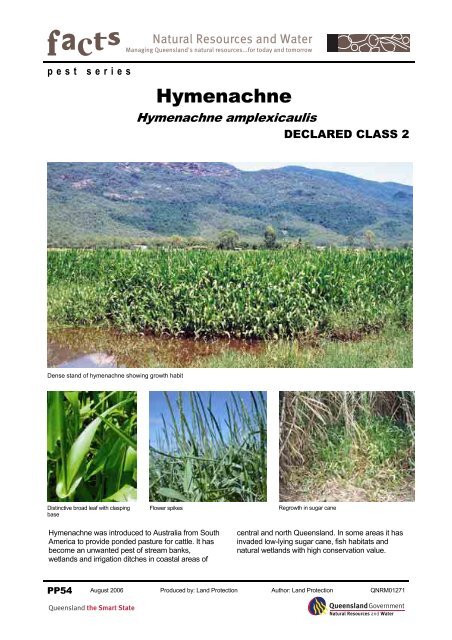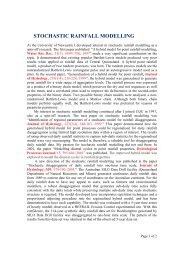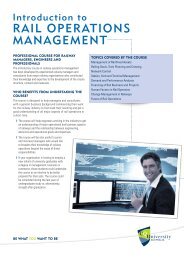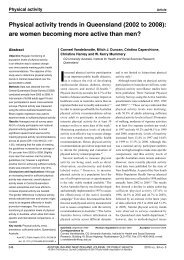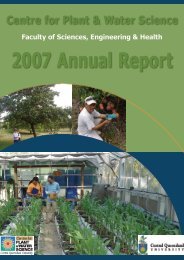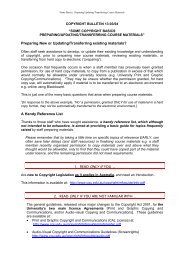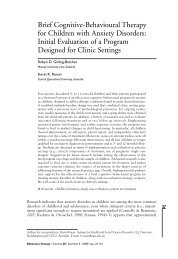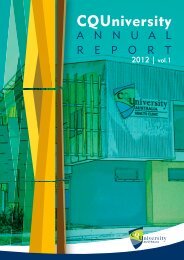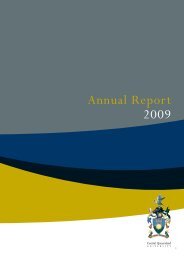Hymenachne - PP54 - Central Queensland University
Hymenachne - PP54 - Central Queensland University
Hymenachne - PP54 - Central Queensland University
Create successful ePaper yourself
Turn your PDF publications into a flip-book with our unique Google optimized e-Paper software.
pest seriesNatural Resources and WaterManaging <strong>Queensland</strong>'s natural resources...for today and tomorrow<strong>Hymenachne</strong><strong>Hymenachne</strong> amplexicaulisDECLARED CLASS 2Dense stand of hymenachne showing growth habitDistinctive broad leaf with claspingbaseFlower spikesRegrowth in sugar cane<strong>Hymenachne</strong> was introduced to Australia from SouthAmerica to provide ponded pasture for cattle. It hasbecome an unwanted pest of stream banks,wetlands and irrigation ditches in coastal areas ofcentral and north <strong>Queensland</strong>. In some areas it hasinvaded low-lying sugar cane, fish habitats andnatural wetlands with high conservation value.<strong>PP54</strong> August 2006 Produced by: Land Protection Author: Land Protection QNRM01271<strong>Queensland</strong> the Smart StateNatural Resources and Water
<strong>PP54</strong>The problem<strong>Hymenachne</strong> has been used as a ponded pasturespecies for cattle production but has escapedcultivation, invading waterways including drains,lagoons, wetlands, creeks and rivers. Heavyinfestations can affect water bodies in a numberof ways:Flooding<strong>Hymenachne</strong> can increase flooding by reducing theflow capacity of the drainage networks.Interference with irrigation and infrastructureUnder flood conditions, plant material builds up atfences and bridges, collecting other floating debris.The combined weight may cause such structuresto collapse.Water flow to irrigation equipment can be reduceddue to the restrictive action of the roots, thusincreasing pumping times and costs.Destruction of wildlife habitats<strong>Hymenachne</strong> infestations are a physical barrier foraquatic and semi-aquatic animals, restricting theirterritorial movements and breeding activities.Fishery biologists believe that carrying capacity andfish populations available for both commercial andrecreational uses are being significantly reduced.Recreation and aestheticsThe presence of thick areas of hymenachnedegrades water quality for swimming and makesfishing impossible. The natural beauty of an openwater body can be spoilt and further degraded asnative aquatic plants, birds and animals aredisplaced. <strong>Hymenachne</strong> also reduces access towaterways for recreation and wildlife.Declaration details<strong>Hymenachne</strong> is declared as a Class 2 species underthe Land Protection (Pest and Stock RouteManagement) Act 2002. A Class 2 pest is one that hasalready spread over substantial areas of <strong>Queensland</strong>,but its impact is so serious that we need to try andcontrol it and avoid further spread onto properties thatare still free of the pest. By law, all landholders musttry to keep their land free of Class 2 pests and it is anoffence to keep or sell these pests without a permit.Local Governments may issue a notice upon alandholder requiring control of a declared pest.<strong>Hymenachne</strong> has been classified as one of twentyWeeds of National Significance.Description<strong>Hymenachne</strong> is a robust, rhizomatous, perennialgrass that can grow to a height of 2.5 m. Its stemsare erect and contain white pith. Roots may beproduced at the lower nodes. The leaf blades are10–45 cm long and up to 3 cm wide, and stronglyclasp the stem at the leaf base.Flowers heads are spike-like, cylindrical, 20–40 cmlong and sometimes branched. Main floweringoccurs from April to June.Related speciesNative hymenachne (<strong>Hymenachne</strong> acutigluma) isfound in northern Australia, Papua New Guinea,Assam, Burma, Malaysia, Vietnam and Polynesia.Care should be taken not to confuse nativehymenachne with the introduced, weedyhymenachne (<strong>Hymenachne</strong> amplexicaulis).The introduced hymenachne has distinctivestem-clasping leaf bases, whereas nativehymenachne does not. Native hymenachne is atropical species and does not grow south of Mackay.Native hymenachne is not considered invasive or athreat to agriculture or other areas.Life cycle<strong>Hymenachne</strong> grows from seed and from brokenstem fragments. Two main vectors for seed dispersalare water movement and migratory aquatic birds.Stem fragments are readily moved by flowing waterand, in suitable conditions, provide rapidestablishment of hymenachne in new locations.In <strong>Queensland</strong>, the main flowering period usuallyoccurs from April to June, depending on location,with seeds set from late autumn to early spring.However, plants have been observed floweringbetween March and September. There is anecdotalevidence that the plant can flower and set seedsover a longer period of time in unusually wet years.A single flower stalk can produce more than 4000seeds and there is the likelihood of a large soil seedbank. Trial work indicates that in field conditionsseed viability is still 21% after six years.Habitat and distributionOriginally from South and <strong>Central</strong> America,hymenachne was released to the <strong>Queensland</strong>grazing industry in 1988 for use in ponded pasture.It is now found in various locations from Cape Yorkto as far south as Casino in New South Wales and inthe top end of the Northern Territory. There ispotential for hymenachne to colonise suitablehabitats over much of coastal, northern Australia.Management strategiesA control program requires a realistic view of howhymenachne impacts on overall propertymanagement and the control of hymenachne shouldbe integrated in the overall property managementplan.1. Identify and prioritise problem areas• Map hymenachne areas on your property.• Prioritise areas for control and identify seedsources, seed and plant dispersal routes andareas prone to weed invasion.• Focus initial efforts on small, isolatedinfestations.2. Determine control options• Decide on the most appropriate control methodsin the given situation3
<strong>PP54</strong>• Consider integrating control techniques byusing chemical, mechanical and good landmanagement practices with regular follow-uptreatments.3. Schedule control activities• Consider how effective various control methodswill be at different times of the year• Make hymenachne control a regular part ofproperty management and allow for monitoringand follow-up after initial treatment. Ensurefollow-up occurs within three months.4. Managing existing populations.• Heavy grazing in the dry season can decreaseseed production and combined with chemicalcontrol can be a very effective control method.• Treat populations in flood prone areas first.• Use an appropriate herbicide.• Wherever possible treat small actively growingplants as they should be easier to kill.PreventionFloodwater can deposit hymenachne in dams,lagoons, wetlands, rivers and creeks. Monitoring ashort time after flood events should allowidentification of new incursions. Treatment of newinfestations should then be carried out to preventestablishment. Also you should:• reduce nutrient/sediment loads entering waterbodies since hymenachne thrives undernutrient-rich conditions• maintain vegetation along riparian areas sincehymenachne does not like shade or competitionfrom trees.ControlThe best form of weed control is prevention. Alwaystreat weed infestations when they are small. Weedcontrol is not cheap but it is cheaper now than nextyear, or the year after. As there is no ‘quick-fix’ for thecontrol of hymenachne, developing a managementplan and committing to it is essential for the long-termeffectiveness of your efforts.TABLE 1 − PERMITS FOR MINOR OFF-LABEL USEA management plan should be structured yet flexibleenough to allow for uncontrollable externalinfluences such as drought, floods or fluctuatingcommodity prices.The best approach is usually to combine differentcontrol options. Whatever methods are used, alwaysfollow-up and monitor progress.Mechanical/physical controlMechanical or physical removal will not completelyeradicate hymenachne because of the plant’s abilityto reproduce vegetatively from very small pieces.The use of heavy earth moving machinery to removehymenachne from drains has met with somesuccess in north <strong>Queensland</strong>.Grazing controlIn western shires, constant heavy grazing in dryconditions has removed hymenachne from theponded pasture system.Biological controlThere have been no biological control agentsreleased for hymenachne control in Australia. Shoulda biological program commence, agents soughtwould need to be specific for Olive hymenachne toensure that there are no impacts on the nativespecies (<strong>Hymenachne</strong> acutigluma) or other desirablegrasses.Herbicide controlNo herbicides are currently registered for control ofhymenachne but there are four off-label minor usepermits in existence. These appear in thetable below.Before using any herbicide always read the labelcarefully. All herbicides must be applied strictly inaccordance with the directions on the label.Spraying an entire heavy infestation can causehymenachne to sink and result in biological hazardsfrom the rotting vegetation. Large masses ofdecomposing hymenachne may use all the oxygenin the water leading to fish kills. This problem can beavoided by spraying strips of the weed.Further informationFurther information is available from the pestmanagement staff at your local government office.Permit No Herbicide SituationPER7485Effective 1 July 2004 to30 June 2009PER6961Effective 24 September 2003 to30 September 2008PER7039Effective 19 July 2004 to30 June 2009PER9076Effective 19 January 2006 to28 February 2007360 g/L Glyphosate (includes RoundupBiactive & Weedmaster Duo) – 1 L/100Lwater or 10 L/ha delivered by boom360 g/L Glyphosate (includes RoundupBiactive) – Max 14L/ha502 g/L Haloxyfop (Verdict 520) – 770 mL/havia knapsack, handgun or boomspray502 g/L Haloxyfop (Verdict 520) – 770 mL/havia knapsack, handgun or boomspraySpot spray in aquatic and wetland areasFor use in drainage reserves – Mareeba –Dimbulah water supply scheme onlyPonded and non-flowing drainage areas andbanks of flowing waterways – for use bytrained staff – Mackay area onlyPonded and non-flowing drainage areas andbanks of flowing waterways – for use bytrained staff – Cardwell shire onlyThe DETAILS and CONDITIONS on the permit must be adhered to by the person/s wishing to use the products for the purposesspecified in these permits. Please refer to the following web site: www.apvma.gov.au for more information on conditions of use.3
<strong>PP54</strong><strong>Hymenachne</strong> (dark green) invading a water storage<strong>Hymenachne</strong> stems showing rooting at nodes. Broken nodes moved by floodwater or machinery can easily establish infestations elsewhere.■Fact sheets are available from NRW service centres and the NRW Information Centre phone (07 3237 1435). Check our web site to ensure you have the latest version of this fact sheet. The control methods referred to in this Pest Fact should beused in accordance with the restrictions (federal and state legislation and local government laws) directly or indirectly related to eachcontrol method. These restrictions may prevent the utilisation of one or more of the methods referred to, depending on individualcircumstances. While every care is taken to ensure the accuracy of this information, the Department of Natural Resources and Waterdoes not invite reliance upon it, nor accept responsibility for any loss or damage caused by actions based on it.© The State of <strong>Queensland</strong> (Department of Natural Resources and Water) 2006


